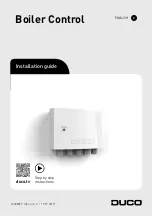
49
8.8 Remote alarm and boiler run indication
As standard the boiler is supplied with 2 x volt free indicators.
- Common alarm signal connect to terminals 21 and 22. Contact closed, opens on
lock out and power loss.
- Boiler run signal connect to terminals 23 and 24. Contact open, closes on boiler
run.
Maximum 230 Volts, 1 amp capacity each.
8.9 Safety interlock
As standard the boiler is supplied with an interlock carrying a 24 Volt boiler control
circuit. To use first remove the fitted wire link (on LH side of terminal block between 10
and 14).
Any external devices required to stop the boiler should then be wired in series and
connected to terminals 10 and 14. Breaking the circuit will activate the safety interlock
and put the boiler into a lock out condition, failure code
12
(flashing). For multiple
boilers connect terminals 10 and 14 on each boiler in parallel to the interlock control,
making sure that the terminal numbers are not mixed.
9 COMMISSIONING
9.1 Initial lighting
1. Isolate main power supply
2. Remove the front panel.
3. Check that the gas supply is available, sound and vented.
4. Open the instrument box.
5. Check that the electrical connections match the control options
6. Open the cap of the automatic air vent.
7. Check boiler and installation is full of water and at the correct pressure
8. Vent the system if necessary.
9. Fill the siphon with water.
10. Close the instrument box.
11. Check the flue and the combustion air supply.
NOTE:
The boiler is suitable for both natural gas and propane firing.
It is supplied as standard set for natural gas, therefore the following procedure must be
carried out BEFORE the boiler is fired and commisioned for the first time on propane.
Adjust the fan speed from 5200 rpm to 4600 rpm (HTG and DHW,
see Par. 6.6.3
and 6.6.8
) and the gas rate screw app. 3 turns clockwise (Quinta 45) or app. 4 turns
clockwise (Quinta 65)
12. Open the gas cock.
13. Re-establish power supply to boiler and controls.











































